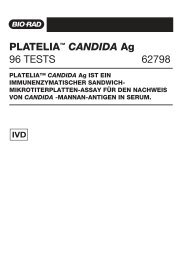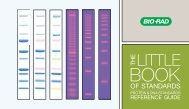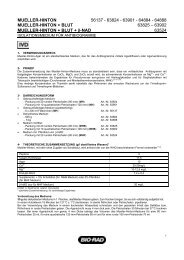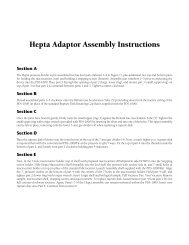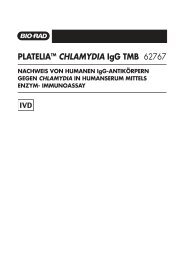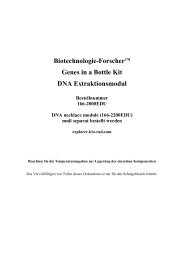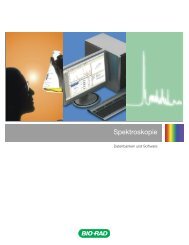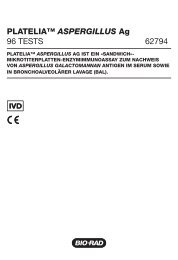Protein Expression and Purification Series - Bio-Rad
Protein Expression and Purification Series - Bio-Rad
Protein Expression and Purification Series - Bio-Rad
Create successful ePaper yourself
Turn your PDF publications into a flip-book with our unique Google optimized e-Paper software.
<strong>Protein</strong> <strong>Expression</strong> <strong>and</strong> <strong>Purification</strong> <strong>Series</strong><br />
Appendix G: <strong>Bio</strong>manufacturing—<strong>Protein</strong> Pharmaceutical<br />
Production Using Genetically Engineered Organisms<br />
Introduction<br />
Industrial biotechnology usually refers to the production of protein pharmaceuticals by living organisms<br />
whose genes have been altered in the laboratory. The Research <strong>and</strong> Development teams of a<br />
biotechnology company construct recombinant DNA molecules in their laboratories, introduce this DNA<br />
into an appropriate cell type, induce that cell to produce the valuable protein product, <strong>and</strong> then develop a<br />
process where the protein of interest can be purified by separating it from other cellular components <strong>and</strong><br />
other proteins. The manufacturing team then takes this cell <strong>and</strong> uses it to produce that pharmaceutical<br />
protein on a large scale.<br />
The genetic engineering revolution started in academic laboratories in the mid-1970s, produced major<br />
business enterprises in the 1980s, <strong>and</strong> matured into a multibillion dollar industry in the 1990s. In the 21 st<br />
century this mode of manufacturing likely will emerge as a dominant industry as a way to manufacture<br />
many more pharmaceuticals, as well as to produce biofuels, textiles, <strong>and</strong> a variety of consumer products.<br />
This process bears some similarities to ancient alchemy. Alchemists tried to turn base metals like lead<br />
into gold. Modern biotechnology companies convert the components of the cell growth media into<br />
pharmaceutically active proteins that are more valuable than gold. The st<strong>and</strong>ard laboratory bacterium,<br />
Escherichia coli, can take the relatively inexpensive components of a simple growth medium, like simple<br />
sugars <strong>and</strong> salts, <strong>and</strong> convert them into a product worth many times its weight in gold.<br />
Appendix G: <strong>Bio</strong>manufacturing<br />
Glucose + Air + Salts ----> Pharmaceutical <strong>Protein</strong>s<br />
Recombinant <strong>Protein</strong> Price per gram<br />
Bovine Growth Hormone (BST) $ 14<br />
Gold 44<br />
Insulin 60<br />
Growth Hormone 227,000<br />
Granulocyte Colony Stimulating Factor 1,357,000<br />
Note: Prices in 2011 dollars<br />
These proteins are worth many times their weight in gold, <strong>and</strong> they often treat diseases for which there<br />
was no treatment before the large-scale production of the protein had been developed. The first protein<br />
produced was insulin to treat diabetes. This bacterial production of insulin replaced pig insulin that had<br />
been isolated from pancreas’ collected from slaughterhouses. Next, recombinant human growth hormone,<br />
to treat Turner syndrome <strong>and</strong> other diseases that produced short stature, replaced growth hormone<br />
isolated from the pituitary gl<strong>and</strong>s of cadavers. Tissue plasminogen activator, an enzyme that triggers the<br />
digestion of blood clots, became the st<strong>and</strong>ard treatment to remove the blood clots in coronary arteries that<br />
caused heart attacks <strong>and</strong> the blood clots in brain arteries that caused strokes. The hormone erythropoietin<br />
raised the level of red blood cells to treat the anemia that accompanies cancer chemotherapy; this protein<br />
is also given to patients on dialysis to treat the anemia associated with kidney failure. <strong>Bio</strong>technology<br />
companies have developed antibodies that specifically recognize proteins on the surface of cancer cells.<br />
These antibodies have been combined with traditional chemotherapy to dramatically increase the treatment<br />
success rates of some of the most aggressive forms of cancer.<br />
Overview—The <strong>Bio</strong>manufacturing Process<br />
<strong>Bio</strong>manufacturing is used to describe the method of producing large quantities of pharmaceutical products<br />
from scalable, validated processes. The manufacturing facilities that grow these cells <strong>and</strong> then purify<br />
229<br />
APPENDIX G<br />
BIOMANUFACTURING




